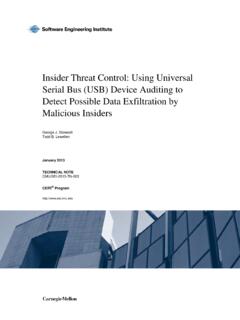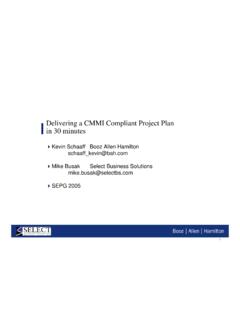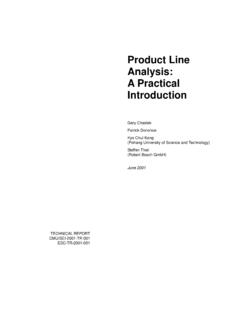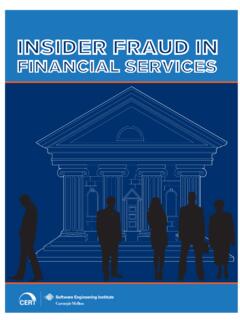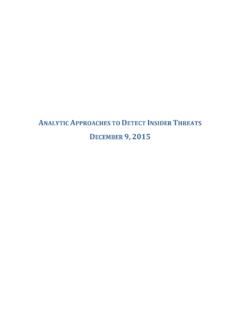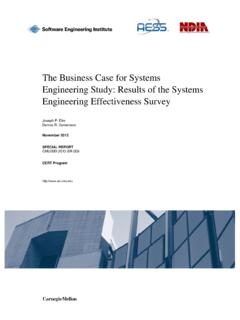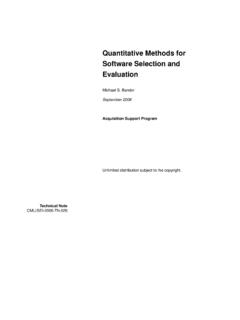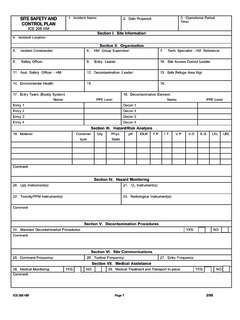Transcription of A Taxonomy of Operational Cyber Security Risks Version 2
1 A Taxonomy of Operational Cyber Security Risks Version 2 James J. Cebula Mary E. Popeck Lisa R. Young May 2014 TECHNICAL NOTE CMU/SEI-2014-TN-006 CERT Division Unlimited distribution subject to the copyright. Copyright 2014 Carnegie Mellon University This material is based upon work funded and supported by DHS DoD under Contract No. FA8721-05-C-0003 with Carnegie Mellon University for the operation of the Software Engineering Institute, a federally funded research and development center sponsored by the United States Department of De-fense. Any opinions, findings and conclusions or recommendations expressed in this material are those of the author(s) and do not necessarily reflect the views of DHS DoD or the United States Department of Defense.
2 This report was prepared for the SEI Administrative Agent AFLCMC/PZM 20 Schilling Circle, Bldg 1305, 3rd floor Hanscom AFB, MA 01731-2125 NO WARRANTY. THIS CARNEGIE MELLON UNIVERSITY AND SOFTWARE ENGINEERING INSTITUTE MATERIAL IS FURNISHED ON AN AS-IS BASIS. CARNEGIE MELLON UNIVERSITY MAKES NO WARRANTIES OF ANY KIND, EITHER EXPRESSED OR IMPLIED, AS TO ANY MATTER INCLUDING, BUT NOT LIMITED TO, WARRANTY OF FITNESS FOR PURPOSE OR MERCHANTABILITY, EXCLUSIVITY, OR RESULTS OBTAINED FROM USE OF THE MATERIAL. CARNEGIE MELLON UNIVERSITY DOES NOT MAKE ANY WARRANTY OF ANY KIND WITH RESPECT TO FREEDOM FROM PATENT, TRADEMARK, OR COPYRIGHT INFRINGEMENT.
3 This material has been approved for public release and unlimited distribution except as restricted be-low. Internal use:* Permission to reproduce this material and to prepare derivative works from this material for internal use is granted, provided the copyright and No Warranty statements are included with all reproductions and derivative works. External use:* This material may be reproduced in its entirety, without modification, and freely dis-tributed in written or electronic form without requesting formal permission. Permission is required for any other external and/or commercial use.
4 Requests for permission should be directed to the Software Engineering Institute at * These restrictions do not apply to government entities. CERT and OCTAVE are registered marks of Carnegie Mellon University. Operationally Critical Threat, Asset, and Vulnerability EvaluationSM DM-0001337 CMU/SEI-2014-TN-006 | i Table of Contents Abstract vii Introduction 1 Taxonomy of Operational Cyber Security Risks 2 Class 1 Actions of People 3 Subclass Inadvertent 3 Subclass Deliberate 4 Subclass Inaction 4 Class 2 Systems and Technology Failures 4 Subclass Hardware 4 Subclass Software 5 Subclass Systems 5 Class 3 Failed Internal Processes 5 Subclass Process Design or Execution 5 Subclass Process Controls 6 Subclass Supporting Processes 6 Class 4 External Events 6
5 Subclass Hazards 7 Subclass Legal Issues 7 Subclass Business Issues 7 Subclass Service Dependencies 7 Harmonization with Other Risk Practices 9 FISMA 10 NIST Special Publications 10 SEI OCTAVE Threat Profiles 11 Conclusion 16 Appendix A: Mapping of NIST SP 800-53 Rev. 4 Controls to Selected Taxonomy Subclasses and Elements 17 Appendix B: Mapping of Selected Taxonomy Subclasses and Elements to NIST SP 800-53 Rev. 4 Controls 30 References 37 CMU/SEI-2014-TN-006 | ii CMU/SEI-2014-TN-006 | iii List of Figures Figure 1: Relationships Among Assets, Business Processes, and Services [Caralli 2010a] 9 Figure 2: Protection, Sustainability, and Risk [Caralli 2010a] 10 Figure 3: OCTAVE Generic Threat Profile for Human Actors Using Network Access 12 Figure 4: OCTAVE Generic Threat Profile for Human Actors Using Physical Access 13 Figure 5: OCTAVE Generic Threat Profile for System Problems 14 Figure 6.
6 OCTAVE Generic Threat Profile for Other Problems 15 CMU/SEI-2014-TN-006 | iv CMU/SEI-2014-TN-006 | v List of Tables Table 1: Taxonomy of Operational Risk 3 Table 2: Mapping of NIST Control Families to Selected Taxonomy Subclasses and Elements 17 Table 3: Mapping of Taxonomy Subclasses and Elements to NIST Controls 30 CMU/SEI-2014-TN-006 | vi CMU/SEI-2014-TN-006 | vii Abstract This report presents a Taxonomy of Operational Cyber Security Risks that attempts to identify and organize the sources of Operational Cyber Security risk into four classes: (1) actions of people, (2) systems and technology failures, (3) failed internal processes, and (4) external events.
7 Each class is broken down into subclasses, which are described by their elements. This report discusses the harmonization of the Taxonomy with other risk and Security activities, particularly those de-scribed by the Federal Information Security Management Act (FISMA), the National Institute of Standards and Technology (NIST) Special Publications, and the CERT Operationally Critical Threat, Asset, and Vulnerability EvaluationSM (OCTAVE ) method. CMU/SEI-2014-TN-006 | viii CMU/SEI-2014-TN-006 | 1 Introduction Organizations of all sizes in both the public and private sectors are increasingly reliant on infor-mation and technology assets, supported by people and facility assets, to successfully execute business processes that, in turn, support the delivery of services.
8 Failure of these assets has a di-rect, negative impact on the business processes they support. This, in turn, can cascade into an inability to deliver services, which ultimately impacts the organizational mission. Given these relationships, the management of Risks to these assets is a key factor in positioning the organiza-tion for success. Operational Cyber Security Risks are defined as Operational Risks to information and technology assets that have consequences affecting the confidentiality, availability, or integrity of information or information systems. This report presents a Taxonomy of Operational Cyber Security Risks that attempts to identify and organize the sources of Operational Cyber Security risk into four classes: (1) actions of people, (2) systems and technology failures, (3) failed internal processes, and (4) external events.
9 Each class is broken down into subclasses, which are described by their ele-ments. Operational Risks are defined as those arising due to the actions of people, systems and technology failures, failed internal processes, and external events. The CERT Program, part of Carnegie Mellon University s Software Engineering Institute (SEI), developed these four classes of Operational risk in the CERT Resilience Management Model [Caralli 2010b], which draws upon the definition of Operational risk adopted by the banking sector in the Basel II framework [BIS 2006]. Within the Cyber Security space, the risk management focus is primarily on opera - tional Risks to information and technology assets.
10 People and facility assets are also considered to the extent that they support information and technology assets. This Taxonomy can be used as a tool to assist in the identification of all applicable Operational Cyber Security Risks in an organization. Toward that end, this report also discusses the harmoniza-tion of the Taxonomy with other risk identification and analysis activities such as those described by the Federal Information Security Management Act of 2002 [FISMA 2002], Security guidance contained within the National Institute of Standards and Technology (NIST) Special Publications series, and the threat profile concept contained within the CERT Operationally Critical Threat, Asset, and Vulnerability EvaluationSM (OCTAVE ) method.
